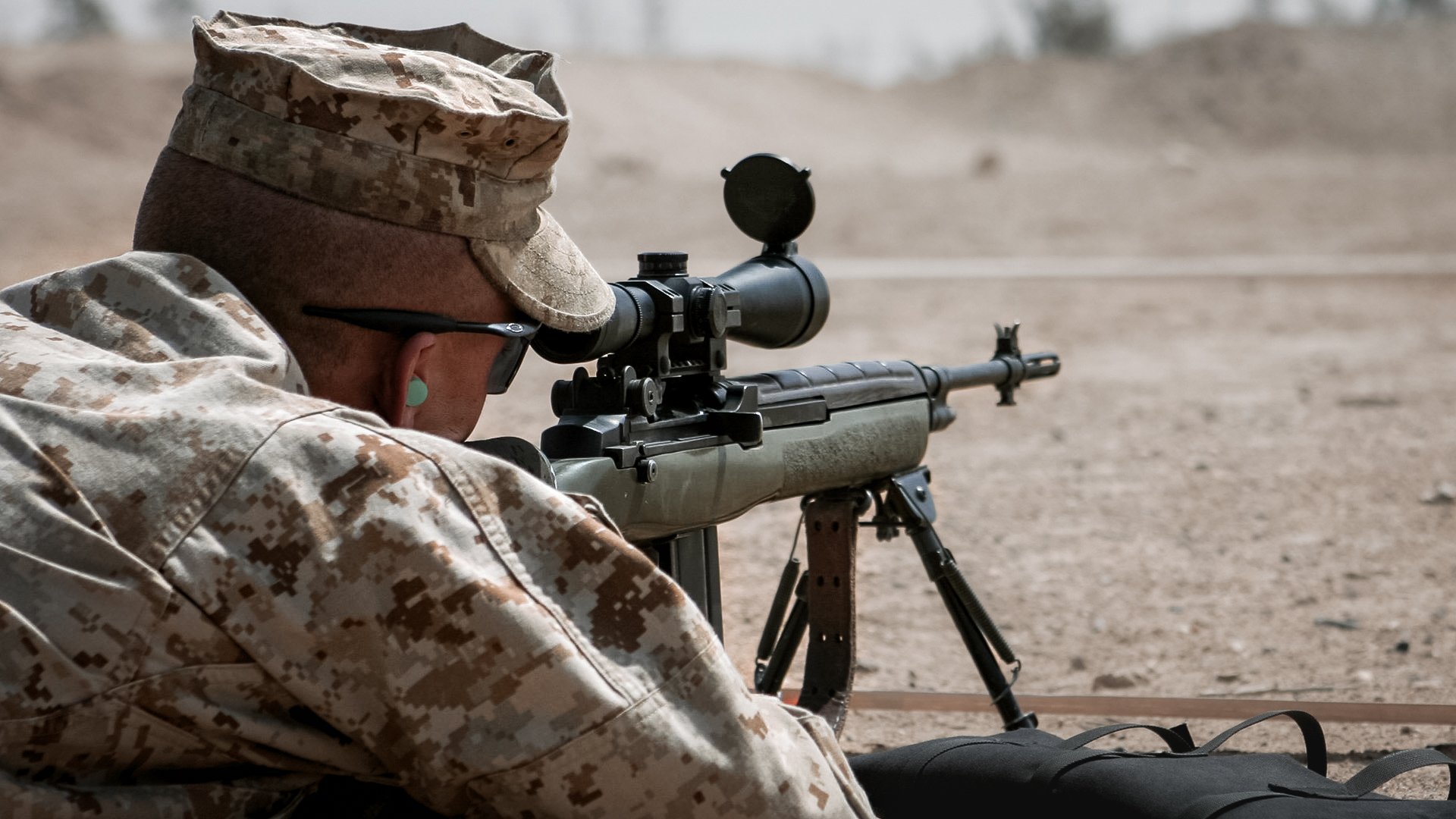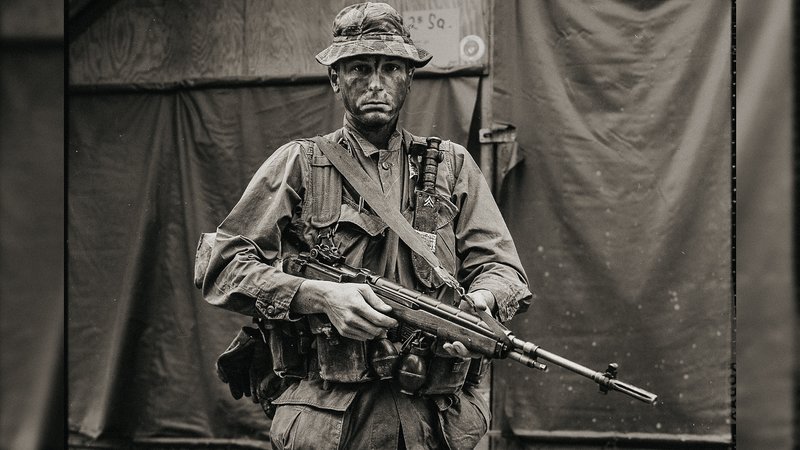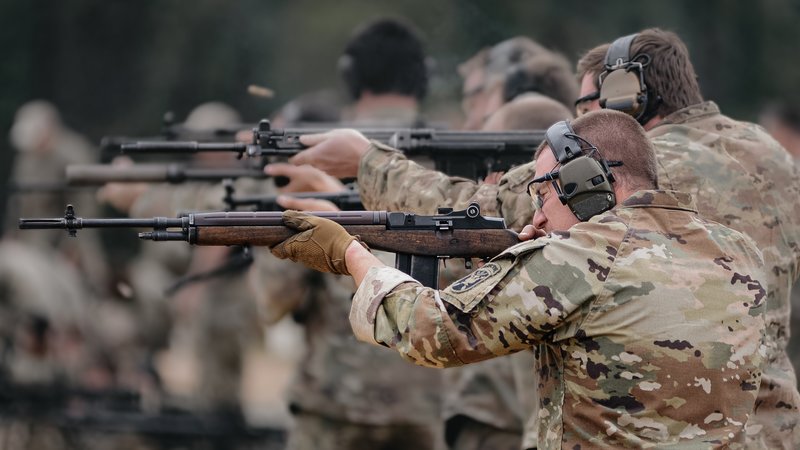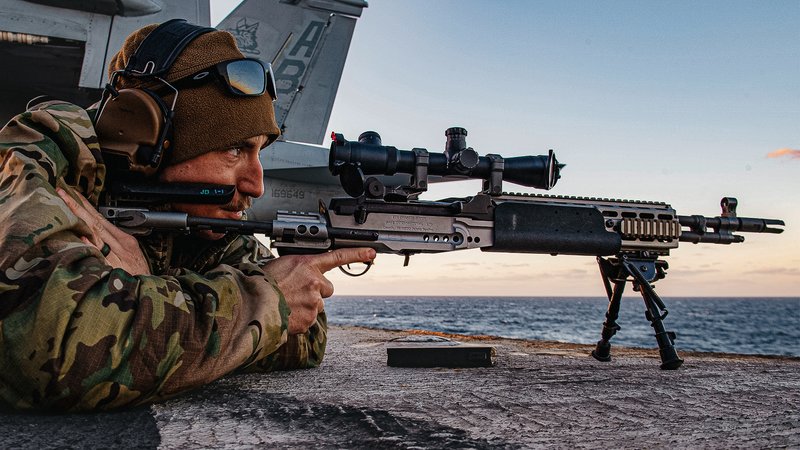
A Marine with 2nd Fleet Anti-Terrorism Security Team Company, Marine Corps Security Force Battalion, prepares to fire his M14. US Marine Corps photo by Cpl. Mike Escobar.
On Feb. 14, 1969, Marine scout sniper Chuck Mawhinney shot and killed 16 North Vietnamese soldiers. The shooting spree raised Mawhinney’s total kill count to 103 enemy soldiers, making him the deadliest sniper in Marine Corps history. But on that fateful Valentine’s Day in Vietnam, Mawhinney wasn’t shooting enemy soldiers with his sniper rifle. Instead, he was wielding the last American battle rifle: the M14.

A Reconnaissance Marine with 3rd Recon Battalion prepares to go on patrol near Phu Bai, 1967. US Marine Corps photo courtesy of Wikimedia Commons.
With its semi automatic capability and 20-round box magazine filled with 7.62mm bullets, the M14 rifle was even deadlier than the bolt action sniper rifles of the day. The M14 was on the cutting edge when it was first manufactured in 1959, but the wet jungles and rice paddies of Vietnam made the M14’s tenure as America’s standard-issue rifle short-lived.
Related: The Marine Corps Scout Sniper With More Confirmed Kills Than Carlos Hathcock

A student assigned to the US Army John F. Kennedy Special Warfare Center and School is in the Special Forces Weapons Sergeant Course fire an M14 rifle during weapons training at Fort Bragg, North Carolina May 13, 2020. US Army photo by K. Kassens.
Three Weapons In One
During World War II, the M1 Garand served as the standard-issue rifle for American GIs. With its eight-round clip of .30-06 bullets, the M1 dominated battlefields in Europe and across the Pacific where it faced off against the slower-firing bolt action Karabiner 98k and Arisaka Type 99. It gave American infantrymen such an advantage that Gen. George Patton called it “the greatest battle implement ever devised.” But following World War II and the Korean War, American arms manufacturers sought to improve upon the design. The US Armed Forces wanted a rifle that could perform the jobs of several standard-issue weapons, namely the M1 Garand, the M1 carbine, and the Browning Automatic Rifle. The result was the M14.

Command Master Chief Michael Kaszubowski, the Ticonderoga-class guided-missile cruiser USS Antietam's (CG 54) command master chief, practices firing a shot line with an M14 rifle on the flight deck. US Navy photo by Mass Communication Specialist 3rd Class Declan Barnes.
The new rifle borrowed the magazine-fed design of the M1 carbine and the automatic fire capability of the BAR, while replacing the M1 Garand as the standard-issue rifle for infantrymen. It maintained a large-caliber round, making it a true battle rifle, though it was upgraded from .30-06 to 7.62x51mm NATO. The larger rounds helped retain the long range and power that made the M1 Garand so beloved.
First issued in 1956, the M14 served as the standard-issue rifle for all US Army and Marine Corps infantrymen. Springfield Armory, Winchester, and Harrington & Richardson manufactured the majority of the more than 1 million M14s produced during the rifle’s seven-year run as America’s standard-issue rifle. Despite being an upgrade from the M1, the M14’s wooden stock tended to swell and warp in Vietnam’s wet climate. Its large-caliber bullets combined with soldiers’ tendency to fire on fully automatic also led to rapid ammunition expenditure. These led Defense Secretary Robert McNamara to end the procurement of the battle rifle, opting instead for American units to transition to the plastic and steel 5.56mm-firing assault rifles and carbines, such as the M16, CAR-15, and, later, the M4. But there’s a reason the relic of the Vietnam War has continued to serve in other capacities to this day.
Related: Death From Afar: How the M40 Earned Its Place Among the Best Sniper Rifles

Spc. Jonathan Low, a designated marksman for Co. C, 2nd Bn., 27th Inf. Rgt., uses the scope on his M14 rifle to scan the horizon from a hilltop in Khoday Nazar Kor during a patrol in 2004. US Army photo.
The Rifle That Just Won’t Quit
Although the M14’s replacements allowed grunts to carry more ammunition, some units continued to opt for the older design. The new 5.56mm rounds tended to veer off course when used in thick brush. The smaller bullets also lost velocity at shorter distances than the M14’s 7.62mm rounds. For those reasons, specially designated Navy SEALs, select Marines, and Army scouts carried the M14 into the 21st century. The M14 was particularly useful in Afghanistan, where engagements frequently took place at great distances.

Explosive Ordnance Disposal Technician 1st Class Connor Lashus, from Dallas, aims an M14 Enhanced Battle Rifle on the flight deck of the Nimitz-class aircraft carrier USS Harry S. Truman (CVN 75) during a live fire exercise, Jan. 19, 2022. US Navy photo by Mass Communication Specialist 3rd Class Christopher Suarez.
Today, the M14 is still used in limited capacities. But as body armor becomes more prevalent on modern battlefields, powerful battle rifles are seeing a resurgence. Green Berets use variants of the M14 in a designated marksman role, while the Navy continues to carry the rifle on ships for security. The Army’s Old Guard and the Air Force’s Honor Guard both use the rifle for funerals and parades. The M14 is also used for drill by the US Military Academy at West Point and the Naval Academy. The M14’s continued use makes it one of the longest serving rifles in American history while simultaneously being one of the shortest-serving standard-issue infantry rifles.
Read Next: M16A2 and M16A4: The OG Black Rifles

Mac Caltrider is a senior staff writer for Coffee or Die Magazine. He served in the US Marine Corps and is a former police officer. Caltrider earned his bachelor’s degree in history and now reads anything he can get his hands on. He is also the creator of Pipes & Pages, a site intended to increase readership among enlisted troops. Caltrider spends most of his time reading, writing, and waging a one-man war against premature hair loss.
BRCC and Bad Moon Print Press team up for an exclusive, limited-edition T-shirt design!
BRCC partners with Team Room Design for an exclusive T-shirt release!
Thirty Seconds Out has partnered with BRCC for an exclusive shirt design invoking the God of Winter.
Lucas O'Hara of Grizzly Forge has teamed up with BRCC for a badass, exclusive Shirt Club T-shirt design featuring his most popular knife and tiomahawk.
Coffee or Die sits down with one of the graphic designers behind Black Rifle Coffee's signature look and vibe.
Biden will award the Medal of Honor to a Vietnam War Army helicopter pilot who risked his life to save a reconnaissance team from almost certain death.
Ever wonder how much Jack Mandaville would f*ck sh*t up if he went back in time? The American Revolution didn't even see him coming.
A nearly 200-year-old West Point time capsule that at first appeared to yield little more than dust contains hidden treasure, the US Military Academy said.












